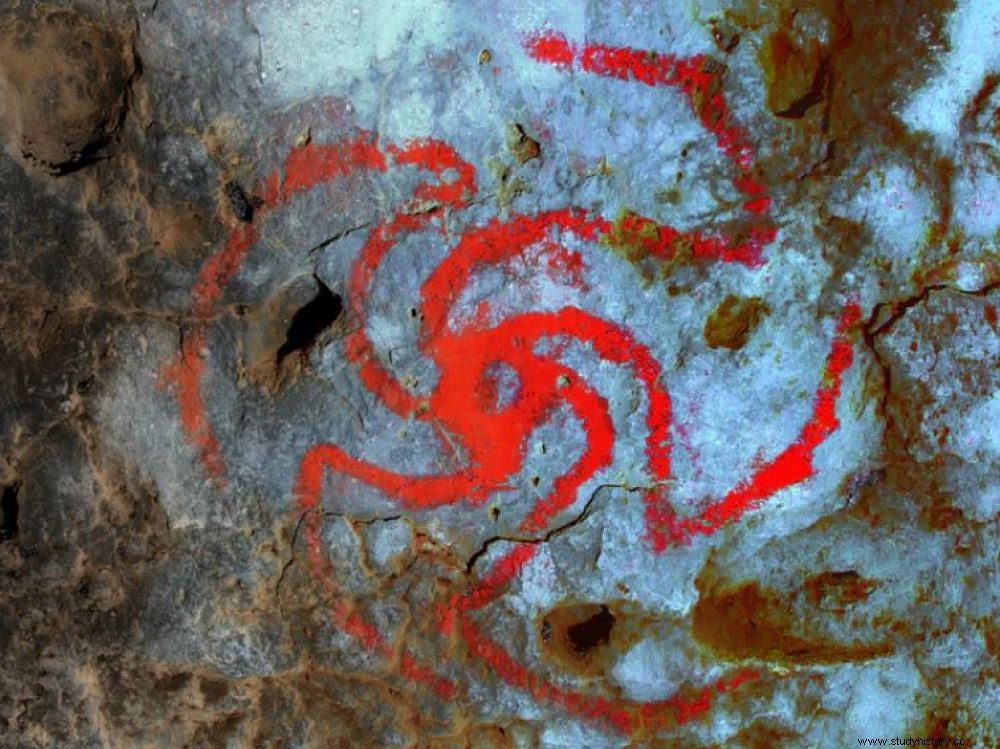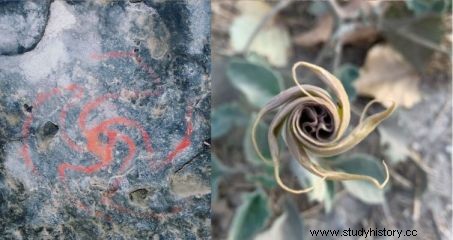Evidence of hallucinogen ingestion at a rock art site has been discovered in California, USA. A first.

Rock art:Depiction of a Datura flower on the cave ceiling in Pinwheel Cave, California.
For the first time, unequivocal proof of the consumption of hallucinogenic plants in a site decorated with rock art has just been revealed in the United States. It was performed in California, in the rock shelter of Pinwheel Cave, south of Bakersfield, on the edge of the traditional territory of the Chumash Native American people.
Remains of dried "quids"
Archaeologists had long noted the presence, on the ceiling of this site, of a figure in the shape of a propeller drawn in red ochre. This is characteristic of the opening of the datura flower, a plant found in Mexico and the western United States, known for its powerful psychoactive properties. But, surprise, archaeologists have just discovered remains of dried "quids", chewed vegetable balls, stuck in the cracks of the cavity, like old chewing gum glued on!

Painting of a datura flower at the Pinwheel Cave site (California) (left). Datura wrightii flower as it closes in the hot hours of the day (right). ©Rick Bury/ Melissa Dabulamanzi / PNAS
In an article published in the journal Proceedings of the National Academy of Sciences (PNAS), the team of researchers presented the analysis of these substances by the method of liquid phase chromatography coupled with mass spectrometry (LC-MS). Chewing was found to contain hallucinogenic alkaloids (atropine and scopolamine) unique to datura wrightii . The fibers of this delicate, highly toxic white flower have also been spotted during examinations carried out using a scanning electron microscope.
Spiritual purposes?
This discovery goes back to the hypothesis put forward by certain specialists in the 1980s that possible modified states of consciousness (EMC) could have influenced the realization of certain graphics on the rock faces. A debate has indeed existed for decades on possible links between hallucinogens, altered state of consciousness and rock art to try to explain the presence of certain abstract figures, sometimes attributed to shamanic visions. However, at Pinwheel Cave where these consumptions of psychoactive compounds have been dated to 1530, the authors of the article do not claim that this discovery suggests a direct link between the absorption of datura and the creation of cave paintings, but rather that this site located in 1999, may have been a ceremonial place where ancient Californians came to consume datura on certain occasions. The painted flower being there to celebrate the importance of the plant rather than a vision obtained under the influence of psychotropic.
For David W. Robinson, archaeologist, senior lecturer at the University of Central Lancashire (UCLAN), (UK), the main signatory of the study, the amount of "pellets" chewed and the number of tools in carved stone found on the surface of the floor of the rock shelter, in particular arrowheads accompanied by food remains, would rather testify to a place used collectively. It could have served as a gathering point before going hunting, or datura could have been consumed to increase stamina and strength. Regional ethnographic sources refer to the use of a drink called toloache , made from the roots of this plant. Deadly in high doses, the consumption of datura could be used as a psychoactive substance for spiritual purposes such as ayahuasca or peyote. In 2019, a 1000-year-old ayahuasca ritual pouch was discovered in a cave in Bolivia (without rock art) at 3900 meters above sea level.
